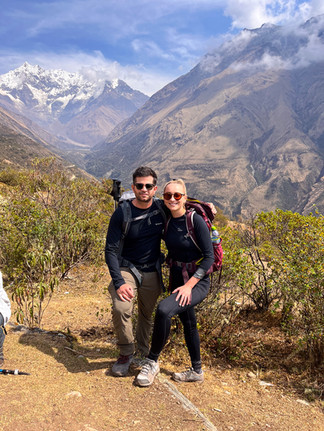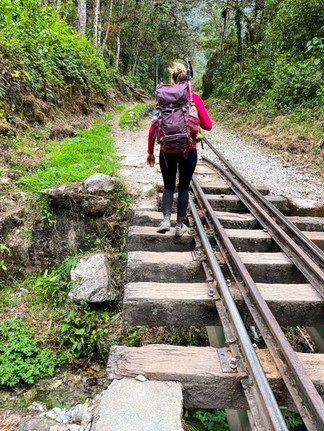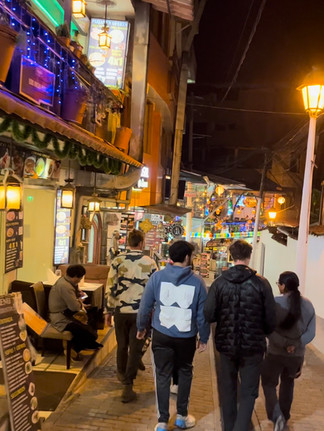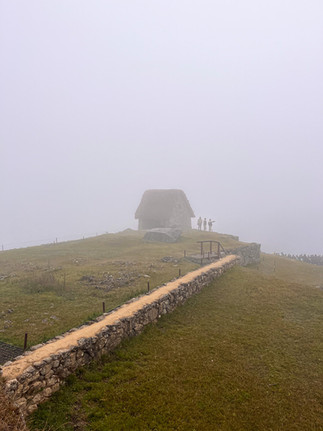Embark On An Epic 84 km Salkantay Trekking Adventure - Hike Machu Picchu in 5 Days!
- Elli
- Aug 9, 2023
- 13 min read
Updated: Aug 10, 2023
Embarking on the Salkantay Trek is an exciting adventure like no other. The stunning landscapes and scenic views take your breath away at every turn. From challenging trails to the beauty of nature, this trekking experience leaves long-lasting memories.
In this article, you can read everything about my and Jake's five-day guided Salkantay Trekking experience in the Andes. With a day-by-day breakdown, I was recounting the challenges that awaited us along the trail and immersing you in the breathtaking landscapes and cultural encounters that made this adventure truly unforgettable.
The Salkantay Pass
While trekking the Salkantay Pass through the Andes, you will ascend to an impressive height of 4.600m/15,190ft in height and cover a total distance of 84 km. You will cross through diverse landscapes, from lush green forests to dry gravel sceneries, while encountering fascinating Incan Ruins and diving into the rich Incan history. Along the way, you also walk sections of the ancient Inca trails, which ultimately lead to the awe-inspiring site of Machu Picchu!
Furthermore, the Salkantay Trek offers a less congested, more picturesque alternative to the renowned Inca Trail, attracting many adventurers and scenic enthusiasts. Throughout the entire journey, trekkers encounter both challenges and rewards, creating truly one-of-a-kind memories.
Last, depending on the tour company, the Salkantay Trek offers a unique accommodation and dining experience for outdoor lovers seeking comfort and adventure. For example, reaching the Sky Camps, Andean Huts, and Jungle domes after a rewarding day of hiking adds more joy and relaxation, elevating the overall trekking experience beyond traditional camping. Also, throughout the journey, Salkanay Trekking chefs prepare nourishing and wholesome breakfasts, lunches, and dinners, creating a sense of camaraderie as the entire trekking group shares the plates of food on one big table.
Note: Jake and I decided to book our trekking tour with Salkantay Trekking (highly recommend)

Arrival and Acclimatize - Cuzco
Acclimatizing is highly recommended when hiking in altitudes exceeding 2.500m (8,200ft). And, since the Salkantay Trek involves crossing the Salkantay Pass at an altitude of 4.630m/15,190ft, acclimatizing becomes necessary. Before you embark on the Salkantay Trek, we highly recommend arriving two days prior in Cusco to avoid altitude sickness!
Upon arrival in Cusco, you can feel that you get quickly out of breath when strolling through the city. Arriving two days before the hike hasn't just helped us get used to the climate and altitude but also helped us mentally prepare for what was about to come the following days.
The afternoon before the trek, we met our Trekking Guides and companion hikers for the first time. We went over the entire trekking itinerary, preparations, and all the information needed to prepare for our trekking begin at 4 a.m. the following day.
Day 1 - Soraypampa & Humantay Lake (7k + 1,5 k hike)
We started our first day by waking up at 3:30 am. Our guides picked us up at 4 am at our hostel in Cusco. After assembling all the other hikers, we continued driving to Mollepata, the final city, before embarking on the trail. By 6 am, we enjoyed a hearty breakfast before proceeding further to Challacancha, the trail's starting point, situated at an elevation of 3.800m/12,467 ft.
Soraypampa - 7 k hike in 3 hours
Venturing on the trail from Challacancha to Soraypampa, we covered a distance of 7 km, completing the hike in approximately three hours. The journey started with an incredible view of distant snow-capped mountains, creating an exciting start to our trip. The following path, which was moderate in difficulty, led us by an ancient Incan irrigation line through the hills.
Accompanied by Jake's good friend Andres from Puerto Rico, we joined a vibrant group of nine international travelers and two local guides. Our spirited group was named "Cosco Runas," inspired by Incan history. Throughout the trek, our guide, Freddy, motivated us with many cheers of "Cosco Runas," filling the hike with enthusiasm and camaraderie. During rest breaks, Freddy shared stories and wisdom passed down from his Incan ancestors.
Upon reaching our Sky Camp accommodation in Soraypampa around lunchtime, we were met with a big feast prepared by the chefs. Various dishes, including avocados, assorted meats, vegetables, rice, and eggs, were generously shared amongst all trekkers and guides. Our hunger was enormous, and the food was satisfying after a long morning of waking up early and trekking our first seven kilometers.

Humantay Lake Hike - 1,5km in 1,5 hours (elevation 4.200m/13,780ft)

After lunch, an optional hike was offered to ascend another mountain to see Humantay Lake. We've already been extremely tired since waking up at 3:30 am and laying down in our beautiful glass igloos sounded just perfect.
Of course, we couldn't lie down and were eager to check out the lake.
The hike to Humantay Lake turned out to be more demanding but also more rewarding than expected. We trekked straight up the mountain, passing gravel paths, crossing a small river, and witnessing beautiful views over the camping valley.
After one hour of trekking, we arrived at the lake, where we could feel the freezing wind blowing around our heads. It was pretty cold up here but incredibly scenic.
The scenic views on our way back down into the valley were breathtaking. We passed by many horses and donkeys freely roaming the area. The horses and donkeys belong to locals who use them to transport hikers and supplies along certain trekking parts.
Despite the relatively short distance, the hike up to Humantay Lake proved to be significantly more challenging, leaving us eager to reach our destination and pass out in our Sky Camp Beds. Little did we know that the day's difficulties were merely the beginning — the following day awaited an even more challenging trek than day one.
Our glass igloos have been one of the many highlights of day one. We received a hot water bottle in the evening that kept us nice and cozy throughout the night. The next day Freddy woke us up with hot Coca tea to our beds. What a service! :)
PS: no showers at the sky camp, only toilets.
Day 2 - The Gringo Killer (7k + 15km in 10 h)
On the second day, we encountered the infamous "Gringo Killer," named by the local guides. Had I known the challenges ahead, I might have hesitated to sign up for this day's hike. The demanding ascent in elevation makes it a highly intimidating journey for most trekkers, and only a select few manage to conquer it without choosing the optional horse ride.
Salkantay Pass - 7k in 4 hours
The day started with an early 5 am wake-up call and a swift breakfast before heading on our hike at 6 am. The trek led us first to Salkantaypampa (4,150m/13,615ft). Onward with a challenging ascent to Soyroccocha (4,490m/14,731ft), and ultimately led up to the highest point of the trek, the Salkantay Pass, perched at an impressive 4,630m/15,190ft elevation. In the span of four hours, we persevered through a 700-meter elevation gain while covering seven kilometers of rugged terrain.
During the trek, some of our companions opted for the assistance of local porters and horses, especially those who struggled with exhaustion or altitude sickness. Nonetheless, reaching the Salkantay Pass filled us with a great sense of achievement. While we enjoyed the breathtaking view of the majestic Salkantay Mountain, Freddy, our guide, shared many ancestral stories and wisdom.

Chaullay - Andean Huts (15k in 6 hours)
As we descended from the Salkantay Pass, we hiked on a continuous downhill trek (lasting 2-3 hours and covering an elevation drop of 700 meters), leading us to Huayracmachay – the designated lunch place. Upon reaching our lunch spot, Jake and I found ourselves pretty exhausted and lacking energy. We underestimated how challenging the first leg of the hike was and should have snacked more frequently to sustain our energy levels.
Following a very satisfying lunch, another adventure awaited us – a three-hour uninterrupted downhill with an impressive 900-meter drop in elevation leading us to the Andean Huts. Along the way, we crossed a narrow path beside a cliff, guiding us into a breathtaking valley, passing by water creeks, donkeys, and horses.
Throughout our journey, our guides, Freddy and Juan De Dios, taught us a lot about the nutritional properties and practical uses of many plants we saw along the paths. Their insights added depth to the experience, allowing us to appreciate the natural wonders surrounding us. On one occasion, as we passed by a particular plant, we found a spider concealed within its foliage, an intriguing encounter I show you further down in the article.

After a challenging and tiring six-hour trek through rugged high-altitude terrain, we were relieved to return to lush greenery. As we approached the welcoming Andean Huts, a nourishing dinner awaited us. While the Andean Huts were super cozy, the restroom facilities presented a more basic experience.
Given the remote mountainous locations, amenities are very simple. While options for toilets and showers exist, adjusting your expectations away from the luxurious comforts of a hotel experience is important. Thankfully, showers were available to freshen up but be prepared for an authentic outdoor adventure.
Day two has proven to be one of the most demanding hikes of our five-day expedition across the Andes. While the first day tested our endurance with an early start, the second day was a true trekking adventure with many uphill stretches and elevation gains.
Day 3 - Passion fruit Plantation, Thermal Baths, Jungle Domes (18km in 5,5 h)
Like every morning, our guides woke us with a hot cup of coca tea by our beds. After getting ready and stashing away our sleeping bags and linens, breakfast awaited us at 5:30 am. For breakfast, we usually had scrambled eggs with bread and fruit. Additionally, the chefs prepared snacking bags with sugary bars, fruits, and juices, thoughtfully packed for all of us to carry along on our hike.
Day three started at an elevation of 2.900m/9,500ft. We hiked through beautiful valleys, crossing waterfalls and rivers while gradually leading us into lower altitudes of lush green scenery.
Wiñaypoqo - Passion Fruit Plantation
Following a two-hour trek, we reached a passion fruit plantation surrounded by a beautiful open area oasis inviting hikers to rest and rejuvenate. The plantation offered freshly squeezed passion fruit juice and various other citric fruits for purchase. We have tasted passion fruits there that we have never previously seen nor tried before. The surrounding area also offered space for enthusiastic hikers to play soccer games, relax in hammocks, or rest in the grass area.
Loreta - Local Coffee Experience
Continuing along the route, we arrived at a Coffee Farm where local farmers introduced us to the entire coffee production process, starting from the cultivation of the coffee plant to the final steaming cup of freshly brewed coffee. While standing between coffee plantations learning everything about the plant and its coffee-making process, mosquitoes became a big distraction, eating us alive.
After learning a lot about the coffee plant and its cultivation, we moved to the process of coffee bean roasting, where we had the opportunity to partake in the roasting process and taste our own freshly roasted coffee beans. At the end of the coffee tour, we enjoyed a freshly brewed cup of coffee and were offered to purchase coffee beans from the local farmers.
Continuing our adventure, we hiked a little further down to 2.000m/6,700ft elevation, where we bumped into food stands that sold fresh fruits and homemade chocolate bars.
Whenever our guides, Freddy and Juan De Dios, would spot animals or interesting plants along the path, they would teach us everything about them. Remember when I told you about the spider our guides spotted along the route? In the third picture below, you can see a tarantula hiding deep inside a spiral tunnel web.
After a challenging journey of eighteen kilometers and rewarding five-and-a-half hours, we reached our jungle dome accommodations in Lucmabamba at 2,000 meters (6,500 feet). Thanks to our early arrival, the afternoon stretched ahead, offering an opportunity to explore the thermal baths of Cocalmayo, located at an altitude of 1,511 meters (4,957 feet). Freddy organized a van that took us all to the thermal spots. Our entire group was excited to soak our tired muscles in the soothing warmth of the pools. It was an experience we all craved after the challenging past days of trekking.
Little did we know that our adventure wasn't entirely free of surprises. Stepping out of the comforting waters exposed us to blood-thirsty mosquitos, reminding us of the importance of packing mosquito repellent (which we forgot to bring). Our post-soak glow turned quickly into a battle against incredibly persistent mosquitos, leaving us with a many bites.

Following our rejuvenating dip in the thermal baths, we met and shared drinks with fellow Salkantay Trekkers from Mexico and Argentina. Our new hiking companions, who had accompanied us on the party bus back to our jungle dome accommodations, added another layer of fun to our third trekking day.
Day three has been a fun 18-kilometer hike, offering a nice contrast to the intense challenges of the initial two days. The afternoon granted us a well-deserved relaxation, preparing us for another "gringo killer hike" that awaited us the following day.
Day 4 - The Second Gringo Killer Hike (25k in 9 hours)
Day four started one last time with the comforting ritual of hot cocoa tea delivered right to our beds. Following a nourishing breakfast, we began our journey at 6:30 am, setting foot on the trail again. The final leg of our hiking adventure unfolded as another challenging trek of nine hours, covering a distance of 25 kilometers.
Llactapata Pass - 12km in 5 hours
In the initial stretch, we embarked on an uphill ascent that led us to Llactapata Pass (2,800m/9,200ft). The clouds were so dense that you couldn't see a single tree in front of you (see image above).
Afterward, our journey led us to the ancient grounds of Llactapata, an Incan ruin where we rested our legs. In the images below, you can see an alignment – a line passing through a doorway that seemingly reaches out to touch the mountain upon which Machu Picchu stands, a reminder of the incredible connection between these historical sites.
Pausing at this unique location, Freddy demonstrated how an old Incan calculator system works (second picture above). He also explained to us that the area we were in most likely contains many undiscovered Incan structures covered by nature throughout the years. Due to a lack of financial funding for archaeological explorations, these historic sights remain undiscovered.
In the image below, Jake points towards the distant majesty of Machu Picchu, our trekking adventure's final goal and destination.
Hidroelectrica and Aguas Calientes - 13 km in 4 hours (or train option)
After a demanding five-hour hike, our bodies craved rest and food. We have reached the perfect lunch spot with a few hammocks lining up in the back of the restaurant overlooking the forest. After fueling our stomachs with a nourishing meal, we sank into the hammocks and hardly got back out later.
After replenishing our energy with a satisfying meal and delicious cup of coffee, we pressed on, hiking an additional two kilometers within an hour to reach Hidroeléctrica – a small town with train access. From here, a choice lay before us: a swift train ride to Aguas Calientes or an alternate route, a three-hour trek along the eleven-kilometer train track path.
Although the option of the train was strong, our spirits were set on completing the entire journey on foot. The path from Hidroeléctrica to Aguas Calientes appeared straightforward, leading us to assume it would be a walk in the park. Yet, we quickly realized that it wasn't.
Freddy's warning that most people underestimate the final three-hour stretch was spot on, for the entire trail proved to be a challenging gravel path. Nevertheless, this track alongside the train rails offered a picturesque route, walking by a massive river, crossing bridges, and wandering in between palm trees. The route was truly a scenic one and most definitely an unexpected test of resilience.
In the initial hour, we walked so fast that we almost sprinted along the train tracks, underestimating the challenge ahead. However, as time passed, exhaustion set in, intensified not only by the demanding four-day trek and high-altitude climbs but also by the maddening itch of mosquito bites tormenting my feet.
Upon realizing there was no need to rush to Aguas Calientes, given our exhaustion, we decided to take a momentary break and relax. We discovered a wooden barn on the train tracks that sold snacks and ice cream, which we couldn't resist.
Only five of our original group of nine hikers persevered through the entire journey without using horse or train rides. The beautiful thing about our trekking group was that we hiked the whole trek together. Walking together, we waited for one another at specific points and ultimately crossed the finish line in Aguas Calientes.
Entering civilization felt like crossing the finish line in a massive marathon. We were so happy to have made it. But before arriving at our hotel and indulging in a well-deserved and satisfying hot shower, we faced one last challenge - locating our hotel while hiking uphill through the entire city, which felt like the cherry on top of a big cake, our trekking experience.
Despite our exhaustion, there was little time to rest once we settled into our hotel rooms. We quickly showered and prepared to meet the group for dinner and drinks. The pictures below show a Passion Fruit Pisco Sour, a salmon dish, and our group strolling to a bar to enjoy well-earned refreshments.
Having conquered the challenging four-day trek through the Andes, we had one last early wake-up call remaining – the pinnacle of our journey: witnessing the awe-inspiring wonder of Machu Picchu.
Day 5 - Machu Picchu - we made it!!

There are two options to get to Machu Picchu from Aguas Calientes. You walk, which takes approximately 1,5 to 2 hours, or take the bus, which takes 20 mins. The bus runs every 15 minutes and costs $12 one way or $24 for a roundtrip. You can get information about tickets here.
At 5:30 am, we boarded the bus, eager to reach the entrance and seize the moment we had been excitingly waiting for – the breathtaking view of Machu Picchu. By 6:30 am, we stood at the iconic viewpoint, slightly disappointed as the entire landscape was covered in a dense shroud of misty rain, hiding the majestic mountains that should have been visible. This weather turn was unexpected after days of glorious sunshine during our trek.
Undeterred, we chose to persevere. Standing in the chilly drizzle for five long hours, we patiently waited for the sky to clear and watched as the mist slowly disappeared. Despite thoroughly soaking, the sight gradually unveiled before our eyes made every discomfort worthwhile. The beauty of Machu Picchu, even during fog and rain, left an indelible mark on our trekking journey, and we knew that this extraordinary experience would be cherished forever.
At the iconic viewpoint, we found ourselves in between hundreds of other travelers, all eager to capture the perfect picture. Hours of anticipation led to around eleven am when the sky miraculously cleared up.
During our six-hour stay at Machu Picchu, we explored the entire area in the final hour, immersing ourselves in the richness of Incan history and taking in the incredible breathtaking views surrounding us.
At approximately 1:30 pm, we took a bus back into Town (Aguas Calientes), where we had a quick lunch before boarding the train for our return to Cusco. Unfortunately, we lost track of time and found ourselves rushing to catch the train, leading our entire group on a mad run through a bustling Peruvian market hall. The scene reminded me of something from a movie, like the chaos of "Home Alone," when everyone is frantically trying to catch a plane.
As the evening descended, we arrived to our accommodation in Cusco. The next day brought an unexpected aftermath for me, Elli – my lips were covered in blisters, my feet swollen from relentless mosquito bites, and deep down, I yearned for the comfort of my mother's clean and cozy home in Germany. While the hike had been an absolute joy, it undeniably took a toll on my physical well-being.
Summary
While covering 84 km in four days presented challenges, there was not a single uphill or gravel path we wished to change or skip. The entire journey tested our courage to continue, yet the sense of accomplishment and fulfillment made it all worthwhile.
Beyond the stunning landscapes, the connections we made with fellow international hikers and the insights shared by our local guides were truly exceptional, leaving us with incredible memories to cherish.
For those considering this trek, we highly emphasize the importance of being sufficiently fit to hike the entire route and allowing enough time for acclimatization in Cusco (at least two days) to ensure an enjoyable journey. Also, remember to pack bug spray for the thermal baths to keep the pesky mosquitos at bay. These simple preparations will undoubtedly enhance your experience and make your Salkantay adventure even more rewarding.






































































































































































Comments